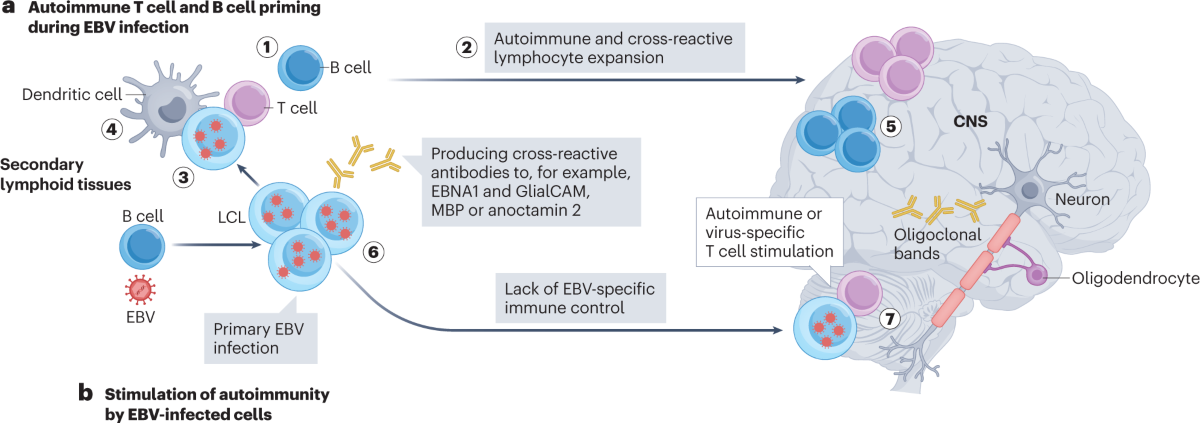The Epstein-Barr virus (EBV) is making headlines again—not just as the culprit behind “mono,” but as a key player in some of the world’s most mysterious autoimmune diseases. Recent studies are unraveling how this incredibly common virus, which infects over 94% of people globally, may be the missing link in conditions like lupus and multiple sclerosis (MS).
The Hidden Power of a Common Virus
Most people catch EBV as children or teens, often with mild or no symptoms. Sometimes, it causes infectious mononucleosis, known for its intense fatigue and sore throat. But for decades, scientists have suspected EBV’s role goes far beyond a passing illness.
Now, a groundbreaking study funded by the Lupus Research Alliance and published in
Science Translational Medicine has revealed how EBV can directly reprogram the body’s immune cells, turning them into “driver” cells that spark autoimmunity in lupus. Dr. William Robinson, the study’s lead author from Stanford, explains that EBV infects B cells—key immune system players—and transforms them into rogue agents that attack the body’s own tissues.
“This research marks an important breakthrough, offering a mechanistic model of how EBV infection may trigger autoimmunity in lupus,” said Dr. Hoang Nguyen of the Lupus Research Alliance.
Epstein-Barr and Multiple Sclerosis: The Evidence Mounts
The EBV-lupus connection isn’t the only headline. New reviews and research from Stanford and other institutions are strengthening the case that EBV is a necessary trigger for multiple sclerosis (MS), a disabling neurological disease. Studies show that people who never contract EBV are almost completely protected from MS, while those who do are at much higher risk.
Researchers believe EBV may set off MS by:
- Immortalizing B cells, which then attack the nervous system
- Disrupting immune regulation and triggering chronic inflammation
New Frontiers: Vaccines and Antiviral Therapies
With this mounting evidence, scientists are racing to develop new ways to fight EBV—not just to prevent mono, but to stop autoimmune diseases before they start. Promising strategies include:
-
EBV-targeted vaccines to prevent initial infection
-
Antiviral drugs that target both latent and active EBV in the body
-
Immunotherapies like engineered T cells that hunt down EBV-infected cells
Some MS treatments already in use, such as B-cell depleting therapies, may work in part by targeting EBV-infected cells. Researchers are also exploring advanced therapies like CAR T cells and CNS-penetrant antibodies.
What This Means for Patients
For millions living with lupus, MS, and other autoimmune diseases, these discoveries offer hope for new treatments—and maybe even prevention. Understanding EBV’s role could lead to therapies that stop these diseases at their source, rather than just managing symptoms.
But experts caution that while the evidence is strong, more research is needed to fully unravel EBV’s complex relationship with autoimmunity and to develop safe, effective interventions.
The Bottom Line
The Epstein-Barr virus, once thought to cause only a mild illness, is now at the center of a medical revolution. As scientists expose its hidden influence on the immune system, the future of autoimmune disease treatment—and prevention—may be forever changed.
Sources
1. Lupus Research Alliance Funds Study to Understand Connection ...
2. The case for targeting latent and lytic Epstein-Barr virus infection in ...
3. Trafficking first, inflammation next: Epstein–Barr virus B cells seed central nervous system T-cell clusters
4. Infectious Mononucleosis - Harvard Health
5. Epstein-Barr Virus | Diagnosis & Disease Information
6. MedStory: From Mono to MS | Department of Medicine News
7. IgM Positivity for Both EBV and CMV: A Clinical Conundrum
8. Development of Epstein Barr virus biosensor by mimicking its ...
9. NCT00032513 | Genetic Studies of Chronic Active Epstein-Barr ...
10. Science Translational Medicine | AAAS
